Voet D., Voet Ju.G. Biochemistry
Подождите немного. Документ загружается.


peroxidase reactions, helping to destroy peroxides generated
by oxidases; it is involved in leukotriene biosynthesis (Sec-
tion 25-7Cb); and the balance between its reduced (GSH)
and oxidized (GSSG) forms maintains the sulfhydryl groups
of intracellular proteins in their correct oxidation states.
The ␥-glutamyl cycle, which was elucidated by Alton
Meister, provides a vehicle for the energy-driven transport
of amino acids into cells through the synthesis and break-
down of GSH (Fig. 26-46). GSH is synthesized from gluta-
mate, cysteine, and glycine by the consecutive action of ␥-
glutamylcysteine synthetase and GSH synthetase (Fig.
26-46, Reactions 1 and 2).ATP hydrolysis provides the free
energy for each reaction. The carboxyl group is activated
for peptide bond synthesis by formation of an acyl phos-
phate intermediate:
The breakdown of GSH is catalyzed by ␥-glutamyl
transpeptidase, ␥-glutamyl cyclotransferase, 5-oxoprolinase,
and an intracellullar protease (Fig. 26-46, Reactions 3–6).
Amino acid transport occurs because, whereas GSH is
synthesized intracellularly and is located largely within the
cell,␥-glutamyl transpeptidase, which catalyzes GSH break-
down (Fig. 26-46, Reaction 3), is situated on the cell mem-
brane’s external surface and accepts amino acids, notably
cysteine and methionine. GSH is first transported to the
NH
2
+
O
ATP
P
i
O
–
C
R
O
N
H
C
R
O
C
R
R⬘
R⬘
ADP
3
OPO
2–
Section 26-4. Amino Acids as Biosynthetic Precursors 1061
Figure 26-45 Some reactions involving glutathione. The
reactions and enzymes are (1) peroxide detoxification by
glutathione peroxidase, (2) regeneration of GSH from GSSG by
glutathione reductase (Section 21-2Ba), (3) thiol transferase
modulation of protein thiol–disulfide balance, and
(4) leukotriene biosynthesis by a glutathione-S-transferase.
Figure 26-46 Glutathione synthesis as part of the ␥-glutamyl
cycle of glutathione metabolism. The cycle’s reactions are
catalyzed by (1) ␥-glutamylcysteine synthetase, (2) glutathione
Leukotrienes
2GSH
NADP
+
NADPH
ROOR
Protein
2ROH
GSSG
4
2
1
3
S
S
Protein
SH
SH
H
3
NCH
2
+
H
3
N
+
COO
–
CH
2
C
O
CN
H
CH
2
COO
–
COO
–
C N
H
C
H
H
Glutathione
Cys-Gly
Glycine
H
3
NCH
2
CH
2
H
2
C
Amino acid
(internal)
+
COO
–
CH
2
C
O
AAC
H
OH
2
C
NH
3
+
CH
2
SH
C COO
–
–
OOC CH
N
H
CO
H
Cysteine
5-Oxoproline
CH
2
SH
H
3
NCH
2
+
COO
–
CH
2
C
O
CN
H
COO
–
C
H
H
␥-Glu-Cys
CH
2
SH
H
3
NCH
2
+
COO
–
CH
2
COO
–
ADP
+ P
i
ATP
ADP
+ P
i
ADP + P
i
ATP
ATP
C
H
Glutamate
5
1
2
6
3
4
Amino acid
(external)
synthetase, (3) ␥-glutamyl transpeptidase, (4) ␥-glutamyl
cyclotransferase, (5) 5-oxoprolinase, and (6) an intracellular
protease.
JWCL281_c26_1019-1087.qxd 4/20/10 9:26 AM Page 1061
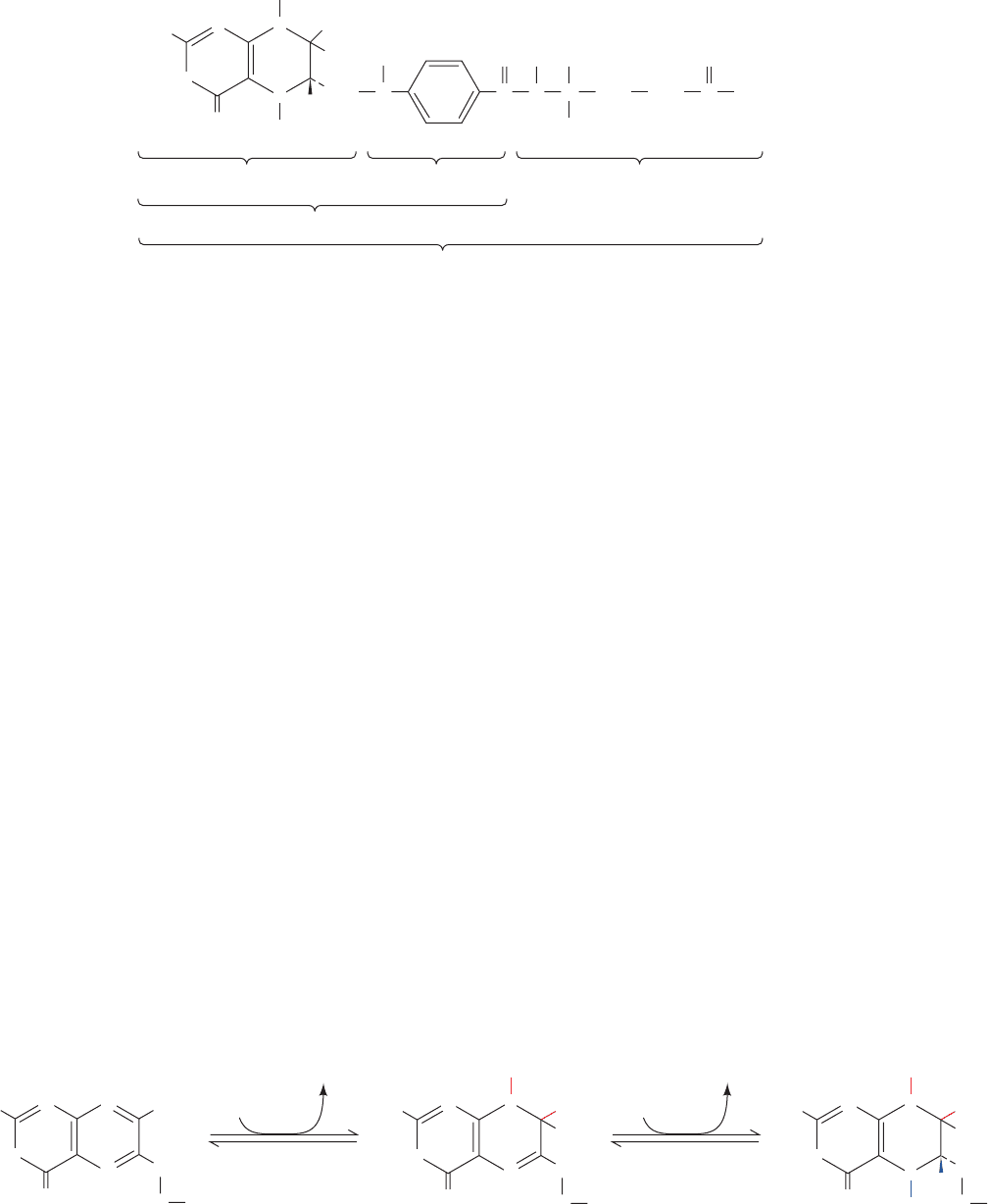
external surface of the cell membrane, where the transfer of
the ␥-glutamyl group from GSH to an external amino acid
occurs. The ␥-glutamyl amino acid is then transported back
into the cell and converted to glutamate by a two-step
process in which the transported amino acid is released and
5-oxoproline is formed as an intermediate. The last step in
the cycle, the hydrolysis of 5-oxoproline, requires ATP hy-
drolysis.This surprising observation (amide bond hydrolysis
is almost always an exergonic process) is a consequence of
5-oxoproline’s unusually stable internal amide bond.
D. Tetrahydrofolate Cofactors: The Metabolism
of C
1
Units
Many biosynthetic processes involve the addition of a C
1
unit to a metabolic precursor. A familiar example is car-
boxylation. For instance, gluconeogenesis from pyruvate
begins with the addition of a carboxyl group to form ox-
aloacetate (Section 23-1Aa). The coenzyme involved in
this and most other carboxylation reactions is biotin (Sec-
tion 23-1Ab). In contrast, S-adenosylmethionine functions
as a methylating agent (Section 26-3Ea).
Tetrahydrofolate (THF) is more versatile than the above
cofactors in that it functions to transfer C
1
units in several
oxidation states. THF is a 6-methylpterin derivative linked
in sequence to p-aminobenzoic acid and Glu residues
(Fig. 26-47). Up to five additional Glu residues may be
linked to the first glutamate via isopeptide bonds to form a
polyglutamyl tail.
THF is derived from folic acid (Latin:folium, leaf), a dou-
bly oxidized form of THF that must be enzymatically re-
duced before it becomes an active coenzyme (Fig. 26-48).
Both reductions are catalyzed by dihydrofolate reductase
(DHFR). Mammals cannot synthesize folic acid and so must
obtain it from their diets or from intestinal microorganisms.
C
1
units are covalently attached to THF at its positions
N5, N10, or both N5 and N10.These C
1
units, which may be
at the oxidation levels of formate, formaldehyde, or
methanol (Table 26-1), are all interconvertible by enzy-
matic redox reactions (Fig. 26-49).
The main entry of C
1
units into the THF pool is as
N
5
,N
10
-methylene-THF through the conversion of serine
to glycine by serine hydroxymethyltransferase (Sections
26-3Bb and 26-5Ae) and the cleavage of glycine by glycine
synthase (the glycine cleavage system; Section 26-3Ba, Fig.
26-14). Histidine also contributes C
1
units through its
degradation with the formation of N
5
-formimino-THF
(Fig. 26-17, Reaction 11).
A C
1
unit in the THF pool can have several fates
(Fig. 26-50):
1. It may be used directly as N
5
,N
10
-methylene-THF in
the conversion of the deoxynucleotide dUMP to dTMP by
thymidylate synthase (Section 28-3Bb).
2. It may be reduced to N
5
-methyl-THF for the synthe-
sis of methionine from homocysteine (Section 26-3Ea).
3. It may be oxidized through N
5
,N
10
-methenyl-THF to
N
10
-formyl-THF for use in the synthesis of purines (Section
1062 Chapter 26. Amino Acid Metabolism
Figure 26-47 Tetrahydrofolate (THF).
Figure 26-48 The two-stage reduction of folate to THF. Both reactions are catalyzed by
dihydrofolate reductase (DHFR).
H
2
N
HN
O
N
N
N
H
H
H
H
CH
2
H
H
N
H
CN
H
O
CCH
2
CH
2
C OH
O
冣
冢
n
COO
–
1
2
3
4
5
6
9
7
8
10
2-Amino-4-oxo-
6-methylpterin
p-Aminobenzoic
acid
Glutamates
(n ⴝ 1ⴚ6)
Tetrahydropteroic acid
Tetrahydropteroylglutamic acid (tetrahydrofolate; THF)
H
2
N
HN
O
N
N
N
CH
2
N
H
R
NADPH
+
H
+
NADP
+
NADPH
+
H
+
NADP
+
H
Folate
H
2
N
HN
O
N
N
N
CH
2
N
H
R
H
H
H
7,8-Dihydrofolate
(DHF)
7
8
H
2
N
HN
O
N
N
N
CH
2
N
H
R
H
H
H
H
H
Tetrahydrofolate
(THF)
5
10
JWCL281_c26_1019-1087.qxd 6/8/10 9:38 AM Page 1062
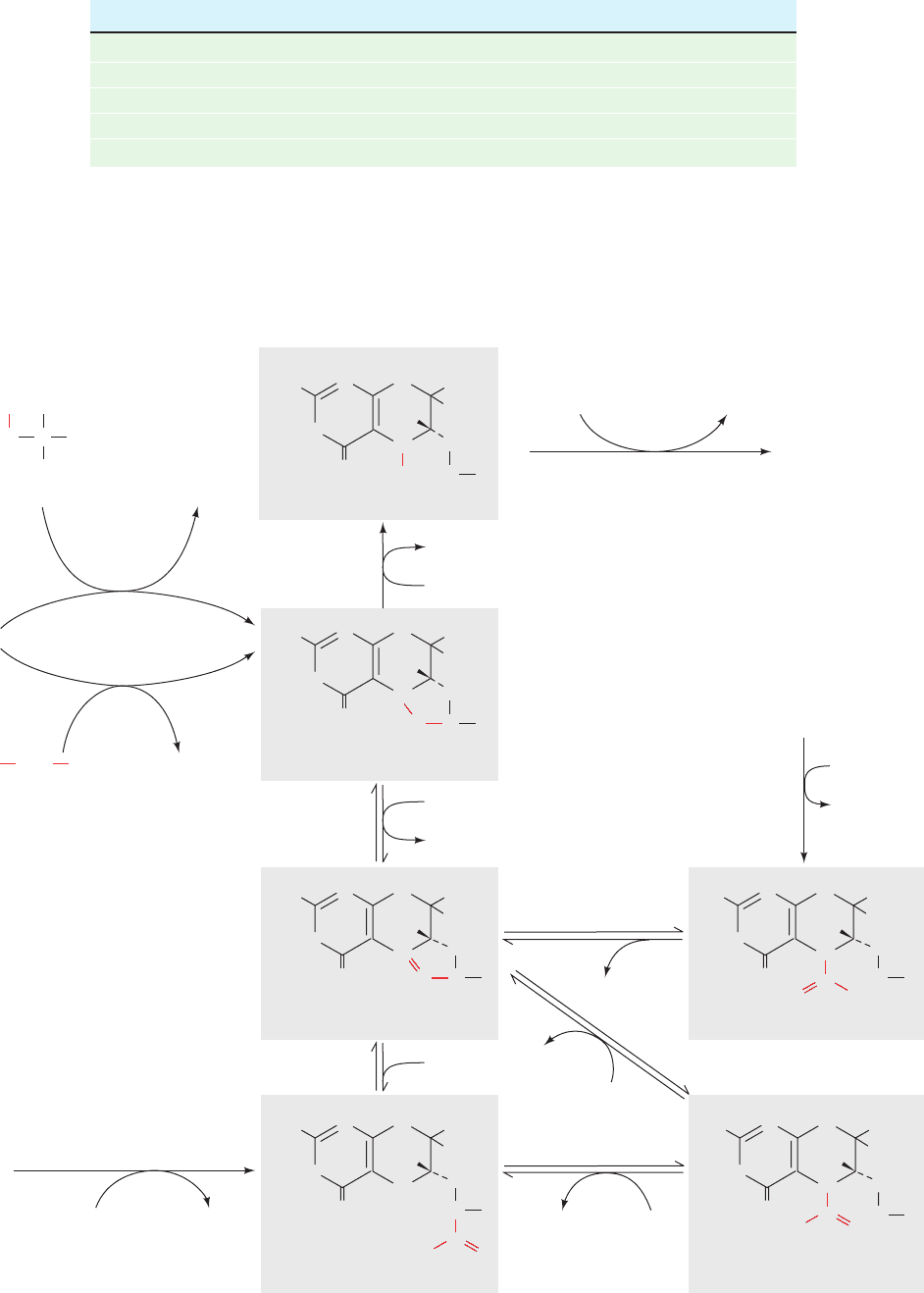
28-1A). Since the purine ring of ATP is involved in histidine
biosynthesis in microorganisms and plants (Section 26-5Be),
N
10
-formyl-THF is indirectly involved in this pathway as
well.Prokaryotes use N
10
-formyl-THF in a formylation reac-
tion yielding formylmethionyl-tRNA, which they require for
the initiation of protein synthesis (Section 32-3Ca).
Section 26-4. Amino Acids as Biosynthetic Precursors 1063
Table 26-1 Oxidation Levels of C
1
Groups Carried by THF
Oxidation Level Group Carried THF Derivative(s)
Methanol Methyl (¬CH
3
) N
5
-Methyl-THF
Formaldehyde Methylene (¬CH
2
¬) N
5
,N
10
-Methylene-THF
Formate Formyl (¬CH“O) N
5
-Formyl-THF, N
10
-formyl-THF
Formimino (¬CH“NH) N
5
-Formimino-THF
Methenyl (¬CH“) N
5
,N
10
-Methenyl-THF
Figure 26-49 Interconversion of the C
1
units carried by THF.
H
N
H
N
H
2
N
N
N
HN
CH
2
RN
H
H
-Methyl-THF
H
H
5
10
NADP
+
C
3
H
N
5
+
H
+
NADPH
H
2
N
N
N
O
HN
CH
2
RN
H
-Methylene-THF
H
H
5
10
2
N
5
C
H
N
10
,
NADP
+
+
H
+
NADPH
H
2
N
N
N
HN
CH
2
RN
H
H
N
H
H
5
10
C
H
N
5
, N
10
-Methenyl-THF
+
H
2
N
N
N
H
HN
CH
2
RN
H
H
N
-Formyl-THF
H
H
5
10
N
C
10
H
2
O
OH
H
2
N
N
N
HN
RN
H
H
H
N
-Formyl-THF
H
H
5
10
N
C
5
OH
H
2
N
N
N
HN
NH
4
RN
H
H
H
N
-Formimino-THF
H
H
5
10
N
5
C
HHN
ADP +
P
i
ATP
NH
3
ATP
ADP
+
P
i
N
5
-formimino-THF
cyclodeaminase
Histidine
+
Glutamate
THF
THF
CH
2
N
5
, N
10
-methenyl-THF
reductase
ADP +
P
i
ATP+
HCO
2
–
Formate
THF
-formyl-THF
synthetase
N
10
Homocysteine Methionine
methionine synthase
N
5
, N
10
-methenyl-THF
cyclohydrolase
N
5
,N
10
-methylene-THF
reductase
serine
hydroxymethyl-
transferase
glycine
cleavage
system
NH
4
+CO
2
+ NADH
+
COOCH
2
+
NAD
N
3
H
+
Glycine
–
Glycine
THF
COOC
C
2
H
–
H
NH
3
HO
Serine
+
O O
OO
O
CH
2
+
+
N
10
-formyl-THF
isomerase
JWCL281_c26_1019-1087.qxd 6/8/10 9:38 AM Page 1063

A deficiency in folic acid results in megloblastic anemia, a
condition in which erythrocytes in the blood are replaced by
fewer abnormally large erythrocytes known as macrocytes.
This occurs as a consequence of the lack of N
5
,N
10
-methyl-
ene-THF,which is required for the synthesis of the DNA pre-
cursor deoxythymidine monophosphate from deoxyuridine
monophosphate (Section 28-3Bb). Pernicious anemia (vita-
min B
12
deficiency; Section 25-2Ee) has similar anemic
symptoms. This is because the irreversibility of the reaction
forming N
5
-methyl-THF and the now inactive coenzyme
B
12
–dependent methionine synthase (top of Fig. 26-49), the
only mammalian enzyme that utilizes N
5
-methyl-THF, result
in folates becoming trapped in their N
5
-methyl-THF form.
Consequently, the anemic symptoms of pernicious anemia
may be alleviated by the administration of folic acid but this
does not relieve its neurological symptoms.
Sulfonamides (sulfa drugs) such as sulfanilamide are an-
tibiotics that are structural analogs of the p-aminobenzoic
acid constituent of THF:
They competitively inhibit bacterial synthesis of THF at
the p-aminobenzoic acid incorporation step, thereby block-
ing the above THF-requiring reactions. The inability of
mammals to synthesize folic acid leaves them unaffected
by sulfonamides, which accounts for the medical utility of
these widely used antibacterial agents.
5 AMINO ACID BIOSYNTHESIS
Many amino acids are synthesized by pathways that are
present only in plants and microorganisms. Since mammals
must obtain these amino acids in their diets, these sub-
stances are known as essential amino acids. The other
amino acids, which can be synthesized by mammals from
common intermediates, are termed nonessential amino
NH
O
RS
Sulfonamides
(R = H, sulfanilamide)
H
2
N
O
OH
O
C
-Aminobenzoic acid
H
2
N
p
acids. Their ␣-keto acid carbon skeletons are converted to
amino acids by transamination reactions (Section 26-1A)
utilizing the preformed ␣-amino nitrogen of another amino
acid, usually glutamate.Yet, although it was originally pre-
sumed that glutamate can be synthesized from ammonia
and ␣-ketoglutarate by glutamate dehydrogenase acting in
reverse, it now appears that the predominant physiological
direction of this enzyme is glutamate breakdown (Section
26-1B). Consequently, preformed ␣-amino nitrogen should
also be considered to be an essential nutrient. In this con-
text, it is interesting to note that, in addition to the four
well-known taste receptors, those for sweet, sour, salty, and
bitter tastes, a fifth taste receptor has been characterized,
that for the meaty taste of monosodium glutamate (MSG),
which is known as umami (Japanese: flavor).
The essential and nonessential amino acids for humans
are listed in Table 26-2. Arginine is classified as essential,
even though it is synthesized by the urea cycle (Section
26-2D), because it is required in greater amounts than can
be produced by this route during the normal growth and
development of children (but not adults). The essential
amino acids occur in animal and vegetable proteins. Dif-
ferent proteins, however,contain different proportions of the
essential amino acids. Milk proteins, for example, contain
them all in the proportions required for proper human nutri-
tion. Bean protein, on the other hand, contains an abundance
of lysine but is deficient in methionine, whereas wheat is
deficient in lysine but contains ample methionine.A balanced
protein diet therefore must contain a variety of different
protein sources that complement each other to supply the
proper proportions of all the essential amino acids.
In this section we study the pathways involved in the
formation of the nonessential amino acids. We also briefly
consider such pathways for the essential amino acids as
they occur in plants and microorganisms. You should note,
however, that although we discuss some of the most com-
mon pathways for amino acid biosynthesis, there is consid-
erable variation in these pathways among different species.
In contrast, as we have seen, the basic pathways of carbo-
hydrate and lipid metabolism are all but universal.
A. Biosynthesis of the Nonessential Amino Acids
All the nonessential amino acids except tyrosine are synthe-
sized by simple pathways leading from one of four common
metabolic intermediates: pyruvate, oxaloacetate, ␣-ketoglu-
tarate, and 3-phosphoglycerate. Tyrosine, which is really
misclassified as nonessential, is synthesized by the one-step
hydroxylation of the essential amino acid phenylalanine
(Section 26-3H). Indeed, the dietary requirement for
phenylalanine reflects the need for tyrosine as well. The
presence of dietary tyrosine therefore decreases the need
for phenylalanine. Since preformed ␣-amino nitrogen in the
form of glutamate is an essential nutrient for nonessential
1064 Chapter 26. Amino Acid Metabolism
Figure 26-50 The biosynthetic fates of the C
1
units in the THF
pool.
N
5
-Methyl-THF methionine SAM
epinephrine
phosphatidylcholine
2
histidinepurines
formylmethionyl-tRNA
N
5
,N
10
-Methylene-THF
N
5
,N
10
-Methenyl-THF
thymidylate (dTMP)
1
3
N
10
-Formyl-THF
JWCL281_c26_1019-1087.qxd 4/20/10 9:26 AM Page 1064
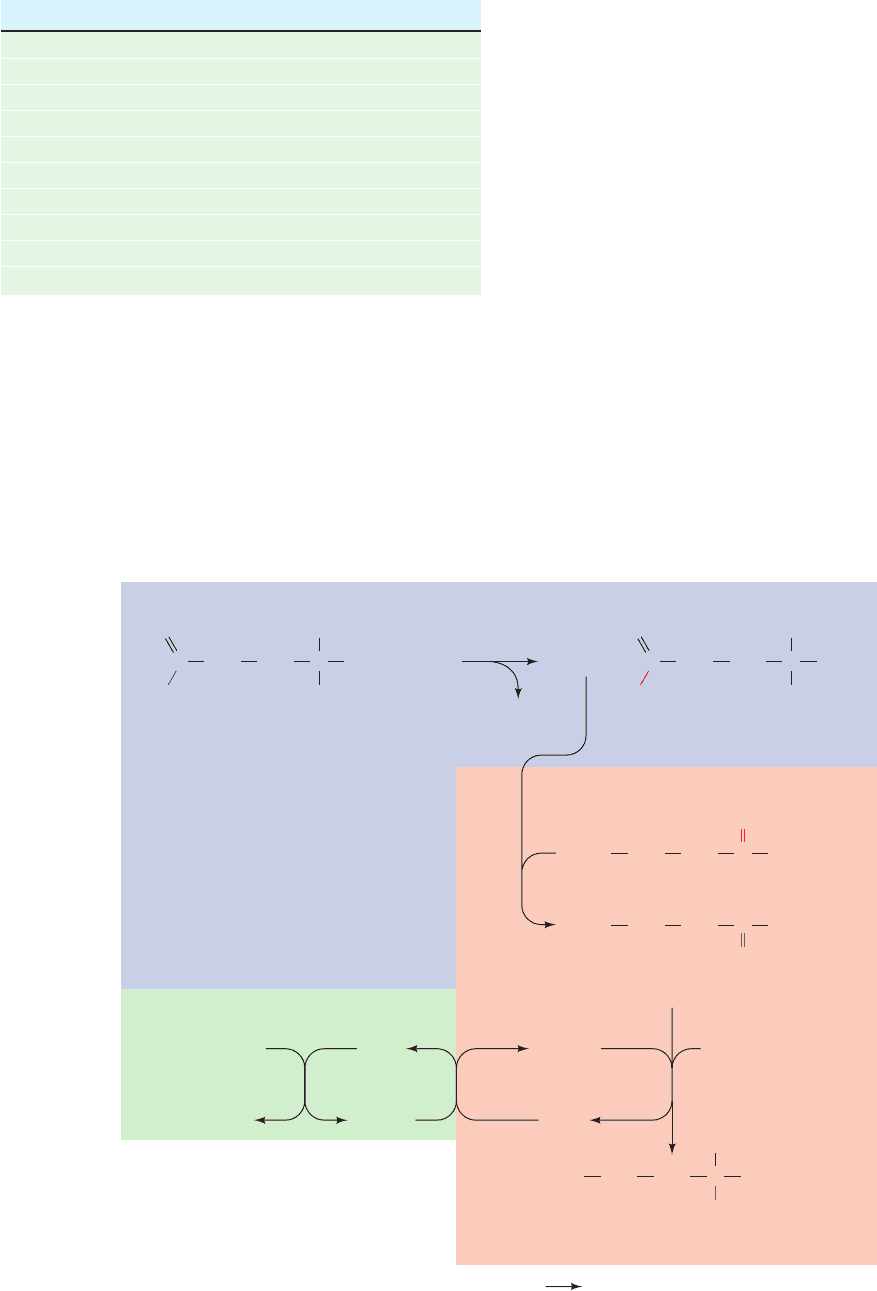
amino acid biosynthesis, we first discuss its production by
plants and microorganisms.
a. Glutamate Is Synthesized by Glutamate Synthase
Glutamate synthase, an enzyme that occurs only in
microorganisms, plants, and lower animals, converts
␣-ketoglutarate and ammonia originating in glutamine to
glutamate.The electrons required for this reductive amina-
tion come from NADPH or ferredoxin, depending on the
organism. The NADPH-dependent glutamate synthase
from the nitrogen-fixing bacterium Azospirillum brasilense,
the best characterized such enzyme, is an ␣
2

2
hetero-
tetramer that binds an FAD and two [4Fe–4S] clusters on
each  subunit,and an FMN and a [3Fe–4S] cluster on each
␣ subunit.The overall reaction is
and involves five steps that occur at three distinct active
sites (Fig. 26-51):
1. Electrons are transferred from NADPH to FAD at
active site 1 on the  subunit to yield FADH
2
.
2. The electrons are transferred from the FADH
2
to
FMN at site 2 on a specific ␣ subunit through the iron–sul-
fur clusters to yield FMNH
2
.
3. Glutamine is hydrolyzed to ␣-glutamate and ammo-
nia at site 3 on the ␣ subunit.
4. The ammonia produced is transferred to site 2 where
it reacts with ␣-ketoglutarate to form ␣-iminoglutarate.
2 glutamate ⫹ NADP
⫹
NADPH ⫹ H
⫹
⫹ glutamine ⫹␣-ketoglutarate
¡
Section 26-5. Amino Acid Biosynthesis 1065
Table 26-2 Essential and Nonessential Amino
Acids in Humans
Essential Nonessential
Arginine
a
Alanine
Histidine Asparagine
Isoleucine Aspartate
Leucine Cysteine
Lysine Glutamate
Methionine Glutamine
Phenylalanine Glycine
Threonine Proline
Tryptophan Serine
Valine Tyrosine
a
Although mammals synthesize arginine, they cleave most of it to form
urea (Sections 26-2D and 26-2E).
Figure 26-51 The sequence of reactions catalyzed by glutamate synthase.
NH
3
+
Glutamine
CC
H
COO
–
+ H
2
O
NH
+
3
NH
+
3
Glutamate
␣-Ketoglutarate
CH
2
COO
–
+ H
2
O
␣ Subunit—site 3
␣ Subunit—site 2
Overall: NADPH
+ H
+
+ glutamine + ␣-ketoglutarate
 Subunit—site 1
CH
2
C
COO
––
OOC
CH
2
CH
2
channeling
3
4
H
+
CC
H
COO
–
CH
2
CH
2
O
H
2
N
Glutamate
C
H
COO
––
OOC
NH
+
3
CH
2
CH
2
5
H
+
FMNH
2
FMN
O
–
O
O
␣-Iminoglutarate
C
–
OOC
CH
2
CH
2
NH
2
FAD
FADH
2
1
NADPH + H
+
2 glutamate
+ NADP
+
NADP
+
JWCL281_c26_1019-1087.qxd 4/20/10 9:26 AM Page 1065
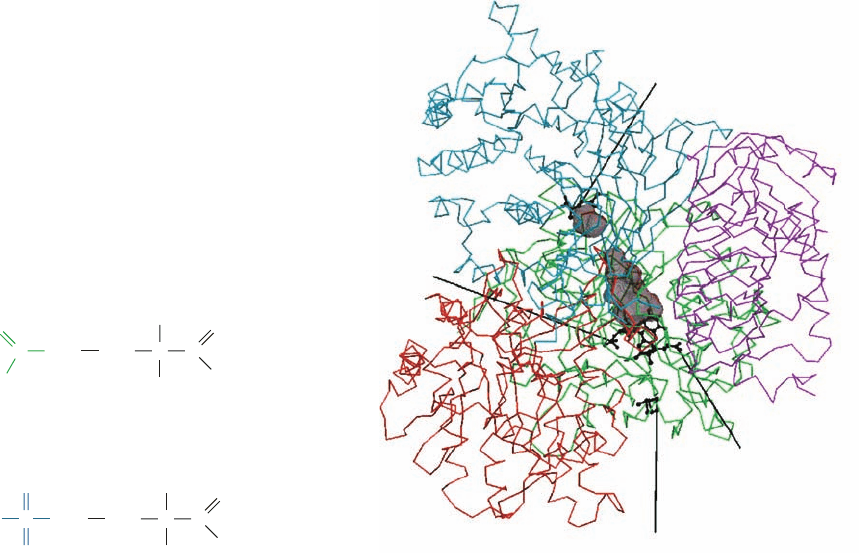
5. The ␣-iminoglutarate is reduced by FMNH
2
to form
glutamate.
In the absence of the  subunit, the ␣ subunit can synthe-
size glutamate from glutamine and ␣-ketoglutarate using
an artificial electron donor; moreover,it is homologous and
functionally similar to ferredoxin-dependent glutamine
synthases. The A. brasilense ␣ subunit is therefore consid-
ered to be the enzyme’s catalytic core.
The X-ray structure of the 1479-residue ␣ subunit of A.
brasilense glutamate synthase in complex with a [3Fe–4S]
cluster, an FMN, an ␣-ketoglutarate substrate,and a methio-
nine sulfone inhibitor (a tetrahedral transition state analog)
was determined by Andrea Mattevi (Fig. 26-52). The subunit
has four domains, an N-terminal glutamine amidotransferase
domain, a central domain, an FMN-binding domain, and a C-
terminal -helix domain (see below). The methionine sul-
fone binds in the N-terminal amidotransferase domain (site
3), where glutamine is normally hydrolyzed via the nucle-
ophilic attack of the Cys 1 sulfydryl group on the glutamine
C
␥
atom to transiently form a tetrahedral intermediate that
the tetrahedral sulfone group mimics. The FMN-binding do-
main consists in large part of an ␣/ barrel, at the mouth of
which the ␣-ketoglutarate and the [3Fe–4S] cluster bind.The
distance between the methyl group on methionine sulfone
(the analog of the glutamine amido group) and the ␣-keto
group of the ␣-ketoglutarate is 31 Å.These two sites are con-
nected by a tunnel through which ammonia must diffuse in
order to react with ␣-ketoglutarate (Reaction 4, Fig. 26-51).
However, the tunnel is blocked by the main chain atoms of
four residues that protrude into the tunnel. Consequently,
there must be at least a 2- to 3-Å shift in the structure during
the reaction to permit ammonia to diffuse between these
sites. Such gating of the tunnel may well be crucial for the
control of enzyme function so as to avoid the wasteful hy-
drolysis of glutamine. In fact, glutamine is hydrolyzed only
when the enzyme has bound ␣-ketoglutarate and reducing
equivalents are available for iminoglutarate reduction.
The C-terminal domain of glutamate synthase consists
largely of a 7-turn, right-handed  helix (Fig. 26-53). In this
unusual motif, the polypeptide chain is wrapped in a wide
helix such that neighboring turns of chain interact as do the
strands of a parallel  sheet.The 43-Å-long glutamate syn-
thase  helix has an elliptical cross section of 16 by 23 Å.
 Helices have been observed in only a handful of mainly
bacterial enzymes. The  helix of glutamate synthase does
C
O
CH
2
H
2
N
C
O
CH
2
H
O
–
NH
3
+
Glutamine
C
C
O
CH
2
H
3
CS
O
O
CH
2
H
O
–
NH
3
+
Methionine sulfone
C
not contain a residue that is involved in catalysis or elec-
tron transfer. However, it does appear to have an impor-
tant structural role because some of its residues line the
tunnel through which ammonia passes.
Glutamine amidotransferase domains or subunits are
part of several protein structures in which glutamine is the
ammonia donor for a further reaction. In glutamate syn-
thase, it is a domain within the ␣ subunit (Fig. 26-52). In
E. coli carbamoyl phosphate synthetase (CPS; Section
26-2Aa), it is a complete subunit within a heterodimer.
These domains or subunits occur in one of two families
that are differentiated by their active site structures. In
CPS, it belongs to the triad family, so called because it con-
tains an active site Cys in a catalytic triad reminiscent of
the catalytic triad in serine proteases (Section 15-3). The
glutamine amidotransferase domain of glutamate syn-
thase belongs to the N-terminal nucleophile (Ntn) family,
which, as we have seen, has an N-terminal Cys that acts as
the active site nucleophile. Other enzymes involved in
1066 Chapter 26. Amino Acid Metabolism
Iminoglutarate
reduction
L-Gln hydrolysis
3Fe–4S
FMN
Figure 26-52 X-ray structure of the ␣ subunit of A. brasilense
glutamate synthase as represented by its C
␣
backbone. The
subunit has four domains, an N-terminal glutamine
amidotransferase domain (blue) to which methionine sulfone (a
glutamine tetrahedral transition state analog) is bound; a central
domain (red); an FMN-binding domain (green) to which an
FMN, a [3Fe–4S] cluster, and an ␣-ketoglutarate are bound; and a
 helix domain (purple).The foregoing ligands are drawn in
black in ball-and-stick form.The 31-Å-long tunnel from the
methyl group on the methionine sulfone (analogous to the amido
group of glutamine) to the ␣-keto group of the ␣-ketoglutarate is
outlined by a gray surface. The tunnel is blocked in this structure
(it is divided into two cavities) by the main chain atoms of four
residues that protrude into the tunnel. [Courtesy of Andrea
Mattevi, Universitá degli Studi di Pavia, Italy. PDBid 1EA0.]
JWCL281_c26_1019-1087.qxd 4/20/10 9:26 AM Page 1066
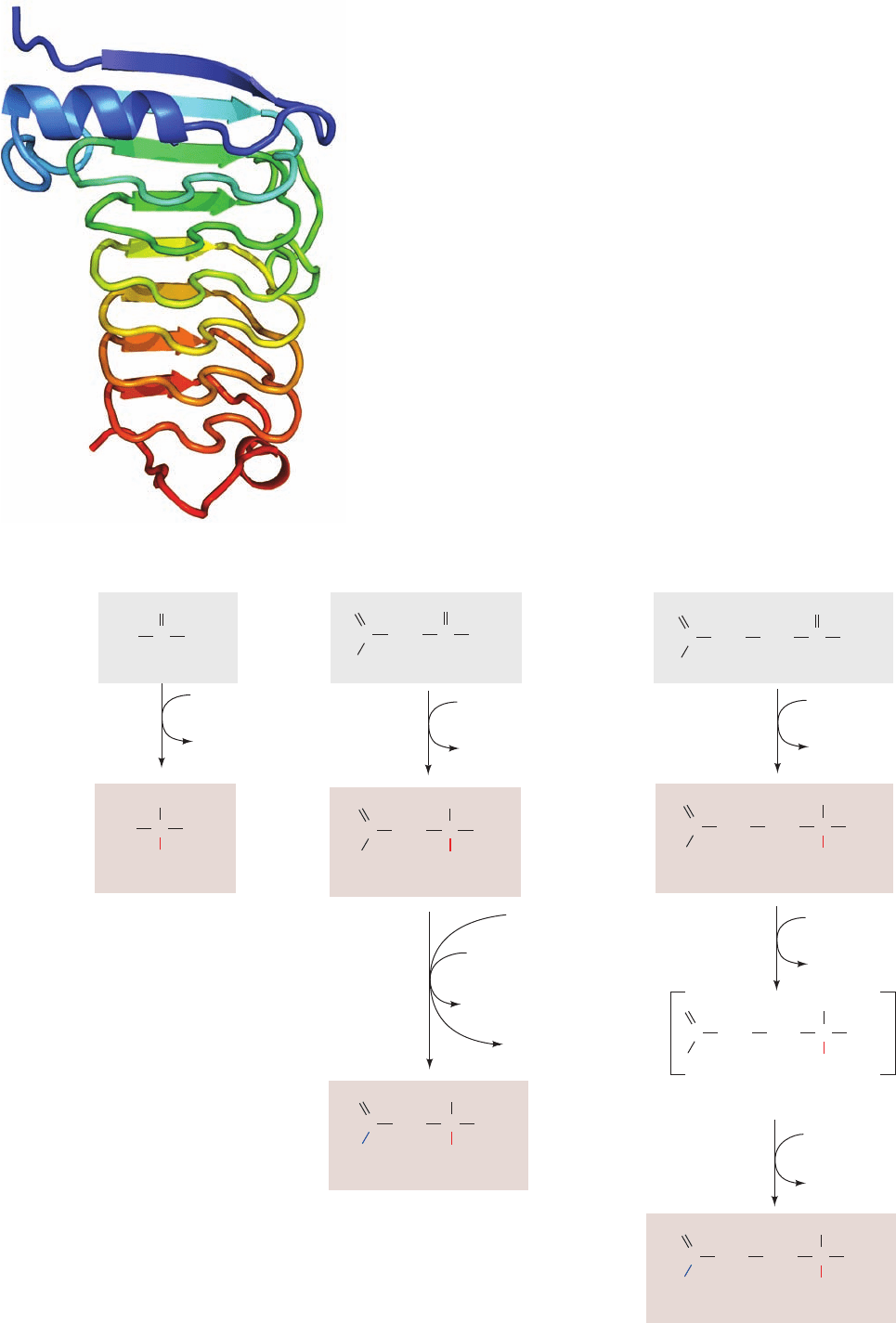
amino acid biosynthesis and having a glutamine amidotrans-
ferase domain include asparagine synthetase (Fig. 26-54,
Reaction 4; see below), a member of the Ntn family, and
imidazole glycerol phosphate synthase (Fig. 26-65, Re-
action 5), which belongs to the triad family. All of these
enzymes have an ammonia-channeling tunnel that connects
the amidotransferase site with the ammonia-utilizing site.
b. Alanine, Asparagine, Aspartate, Glutamate, and
Glutamine Are Synthesized from Pyruvate,
Oxaloacetate, and ␣-Ketoglutarate
Pyruvate, oxaloacetate, and ␣-ketoglutarate are the
keto acids that correspond to alanine, aspartate, and gluta-
mate, respectively. Indeed, as we have seen (Section 26-1),
the synthesis of each of these amino acids is a one-step
Section 26-5. Amino Acid Biosynthesis 1067
Figure 26-53 The  helix of A. brasilense glutamate synthase. The polypeptide
backbone (residues 1225–1416) is colored in rainbow order from its N-terminus
(blue) to its C-terminus (red). Neighboring turns of polypeptide chain within the
 helix interact as do the strands of parallel  sheets. Nevertheless, the
conformations of many of these segments lie outside the normal range for 
strands, and hence they are drawn in coil form. [Based on an X-ray structure by
Andrea Mattevi, Universitá degli Studi di Pavia, Italy. PDBid 1EA0.]
C
Glutamate
CH
2
CH
2
COO
–
NH
3
+
H
C
O
–
O
OPO
3
2
–
C
α
-Ketoglutarate
CH
2
CH
2
COO
–
O
C
O
–
O
ADP
ATP
C
-Glutamylphosphate
intermediate
CH
2
CH
2
COO
–
NH
3
+
H
C
O
γ
glutamine
synthetase
C
Glutamine
CH
2
CH
2
COO
–
NH
3
+
H
C
O
H
2
N
NH
4
+
P
i
C
Aspartate
CH
2
COO
–
NH
3
+
H
C
O
–
O
C
Oxaloacetate
CH
2
COO
–
O
C
O
–
O
4
AMP
ATP
C
Asparagine
CH
2
COO
–
NH
3
+
H
C
O
asparagine
synthetase
PP
i
+
Glutamate
Glutamine
H
2
N
1
Pyruvate
H
3
C
COO
–
O
C
Amino
acid
α-Keto
acid
aminotransferase
Alanine
COO
–
NH
3
+
H
C
H
3
C
2
aminotransferase
3
aminotransferase
5
Amino
acid
α-Keto
acid
Amino
acid
α-Keto
acid
5
Figure 26-54 The syntheses of alanine, aspartate, glutamate, asparagine, and
glutamine. These reactions involve the transaminations of (1) pyruvate, (2) oxaloacetate,
and (3) ␣-ketoglutarate, and the amidations of (4) aspartate and (5) glutamate.
JWCL281_c26_1019-1087.qxd 6/8/10 9:38 AM Page 1067
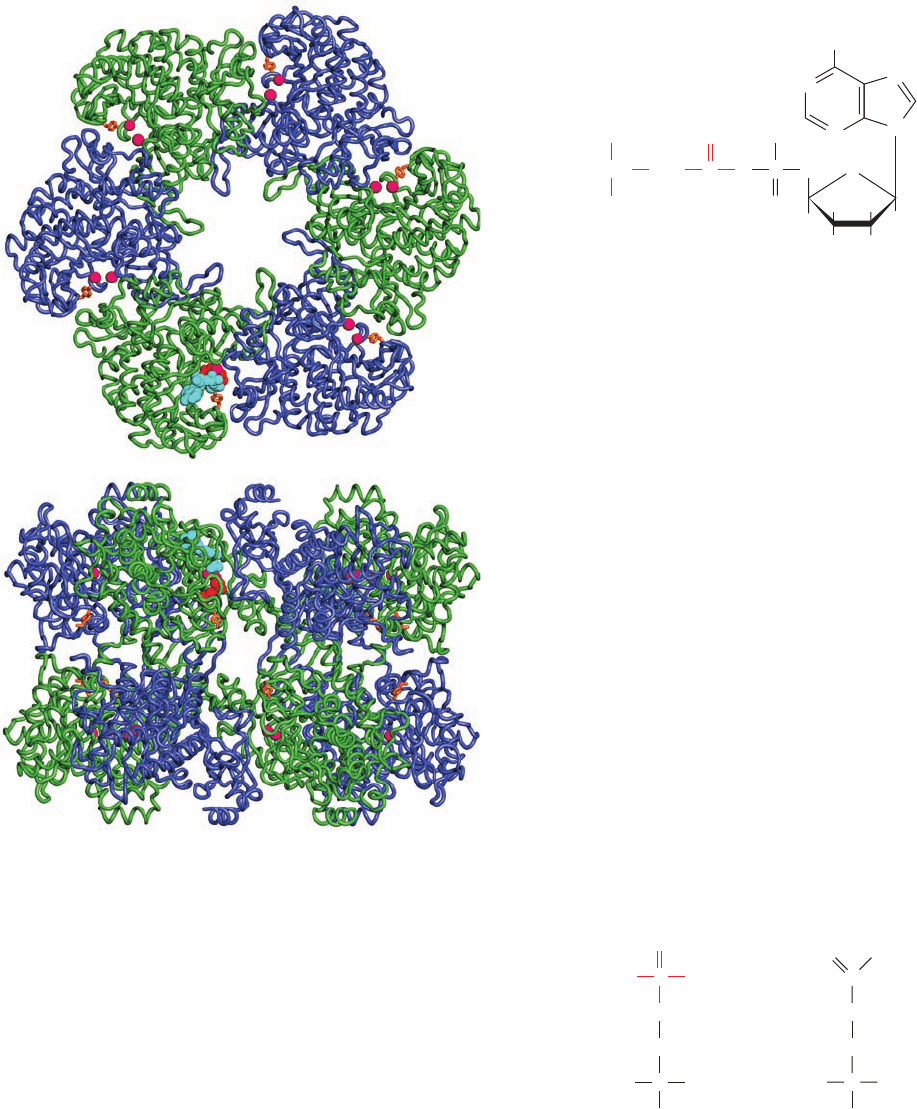
(b)
transamination reaction (Fig. 26-54, Reactions 1–3). As-
paragine and glutamine are, respectively, synthesized from
aspartate and glutamate by amidation (Fig. 26-54, Reactions
4 and 5). Glutamine synthetase catalyzes the formation of
glutamine in a reaction in which ATP is hydrolyzed to ADP
and P
i
via the intermediacy of ␥-glutamylphosphate and
is the amino group donor (Fig. 26-54, Reaction 5). Cu-
riously, aspartate amidation by asparagine synthetase to form
asparagine follows a different route; it utilizes glutamine as
its amino group donor and hydrolyzes ATP to AMP⫹PP
i
(Fig. 26-54, Reaction 4). This enzyme is composed of a gluta-
mine amidotransferase domain of the Ntn family (see above)
and a second domain in which -aspartyl-AMP
is synthesized from Asp and ATP and then reacts with am-
monia to form Asn. As with other glutamine amidotrans-
ferase–containing enzymes, the two domains are connected
by a tunnel that channels ammonia between their two
active sites.
c. Glutamine Synthetase Is a Central Control Point
in Nitrogen Metabolism
Glutamine, as we have seen, is the amino group donor in
the formation of many biosynthetic products, as well as be-
ing a storage form of ammonia. Glutamine synthetase’s
consequent pivotal position in nitrogen metabolism makes
its control a vital aspect of this process. In fact, mammalian
glutamine synthetases are activated by ␣-ketoglutarate, the
product of glutamate’s oxidative deamination.This control
presumably prevents the accumulation of the ammonia
produced by that reaction.
Bacterial glutamine synthetase, as Earl Stadtman showed,
has a much more elaborate control system. This enzyme,
which consists of 12 identical 469-residue subunits arranged
with D
6
symmetry (Fig. 26-55), is regulated by several effec-
tors as well as by covalent modification.Although a complete
description of this complex enzyme is not given here, several
aspects of its catalytic and control systems bear note.
The X-ray structure of Salmonella typhimurium gluta-
mine synthetase in complex with the glutamate structural
analog phosphinothricin,
determined by David Eisenberg, reveals that its catalytic
sites occur at the interface between the C-terminal domain
CH
3
CH
2
P
O
HO
COO
–
H
3
N
+
CH
2
H
Phosphinothricin
C
CH
2
C
O
–
O
COO
–
H
3
N
+
CH
2
H
Glutamate
C
CH
2
CH
2
NH
2
O P
+
NH
3
COO
–
-Aspartyl-AMP
CH
O
–
C
O
O
O
H
HH
H
N
OH OH
N
N
N
NH
⫹
4
1068 Chapter 26. Amino Acid Metabolism
Figure 26-55 X-ray structure of S. typhimurium glutamine
synthetase. The enzyme consists of 12 identical subunits, here
represented by their C
␣
backbones, arranged with D
6
symmetry
(the symmetry of a hexagonal prism). (a) View down the 6-fold
axis of symmetry showing only the six subunits of the upper ring
in alternating blue and green.The subunits of the lower ring are
roughly directly below those of the upper ring.The protein,
including its side chains (not shown), has a diameter of 143 Å.
The six active sites shown are marked by the pairs of Mn
2⫹
ions
(magenta spheres; divalent metal ions, physiologically Mg
2⫹
, are
required for enzymatic activity). Each adenylylation site,Tyr 397
(yellow), lies between two subunits at a higher radius than the
corresponding active site. Also drawn in one active site are ADP
(cyan) and phosphinothricin (orange), a competitive inhibitor of
glutamate. (b) Side view along one of the enzyme’s 2-fold axes
showing only the eight nearest subunits.The molecule extends
103 Å along the 6-fold axis, which is vertical in this view. [Based
on an X-ray structure by David Eisenberg, UCLA. PDBid 1FPY.]
(a)
JWCL281_c26_1019-1087.qxd 4/20/10 9:26 AM Page 1068
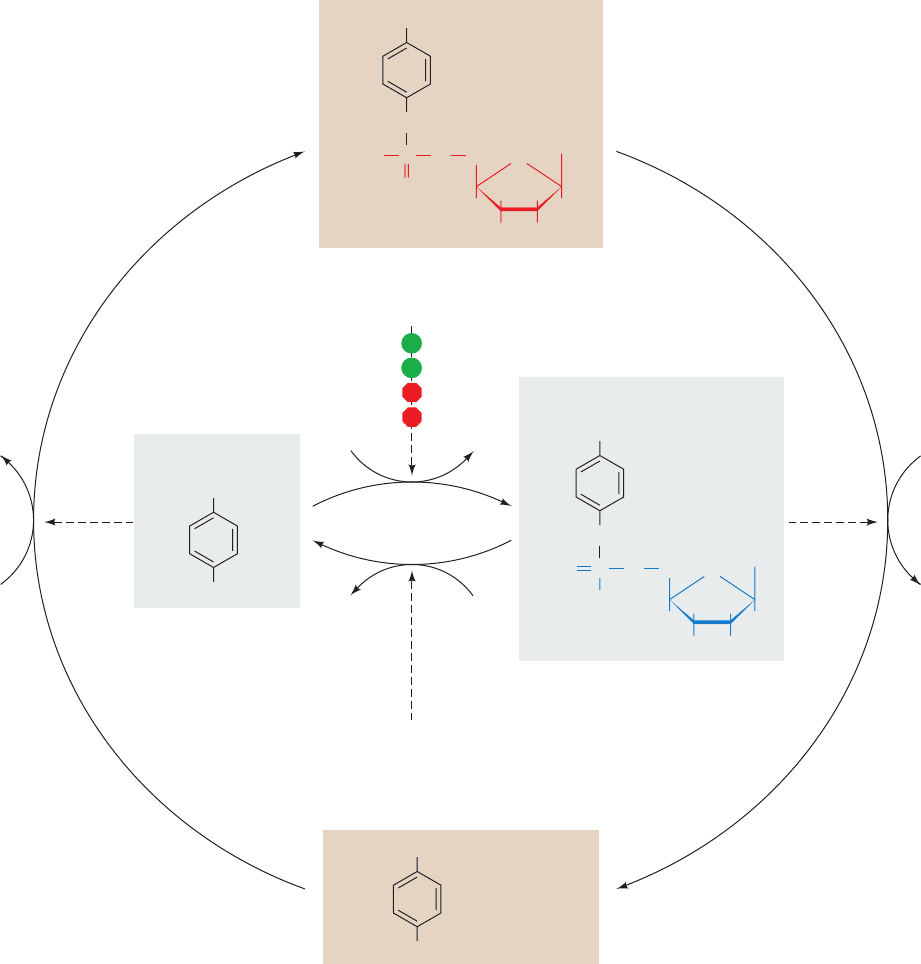
of one subunit and the N-terminal domain of an adjacent
subunit. These catalytic sites have a shape described as a
“bifunnel” that opens at both the exposed top (ATP bind-
ing) and bottom (Glu and binding) of the molecule
(between the two hexameric rings) and is narrow in the
plane of its essential metal ions (two per subunit). Nu-
cleotide binding induces conformational changes that in-
crease the enzyme’s affinity for glutamate and ammonium
ion, leading to an ordered sequential mechanism.
Nine feedback inhibitors cumulatively control the activity
of bacterial glutamine synthetase: histidine, tryptophan, car-
bamoyl phosphate (as synthesized by carbamoyl phosphate
synthetase II), glucosamine-6-phosphate, AMP, and CTP are
all end products of pathways leading from glutamine,
whereas alanine, serine, and glycine reflect the cell’s nitrogen
NH
⫹
4
level. Several of these inhibitors act in a competitive manner,
binding either to the glutamate binding site (serine, glycine,
and alanine) or to the ATP binding site (AMP and CTP).
E. coli glutamine synthetase is covalently modified by
adenylylation of a specific Tyr residue (Fig. 26-56). The en-
zyme’s susceptibility to cumulative feedback inhibition in-
creases, and its activity therefore decreases, with its degree
of adenylylation. The level of adenylylation is controlled by
a complex metabolic cascade that is conceptually similar to
the one controlling glycogen phosphorylase (although the
type of covalent modification differs in that glycogen phos-
phorylase is phosphorylated at a specific Ser residue;Section
18-3Ca). Both adenylylation and deadenylylation of gluta-
mine synthetase are catalyzed by adenylyltransferase in
complex with a tetrameric regulatory protein, P
II
. This
Section 26-5. Amino Acid Biosynthesis 1069
O
P
OH
P
II
α-Ketoglutarate
ATP
Glutamine
P
i
Glutamine synthetase (less active)
Adenylyltransferase
O
–
OO
O
HH
HH
OH OH
CH
2
Adenine
OH
Glutamine synthetase (more active)
O
HH
O
–
POO
O
HH
OH OH
CH
2
Uracil
•
P
II
Adenylyltransferase
Uridylyltransferase
Uridylyl-removing enzyme
•
PP
i
PP
i
A
TP
P
i
ADP
UTP
H
2
OUMP
Figure 26-56 The regulation of bacterial
glutamine synthetase. The
adenylylation/deadenylylation of a
specific Tyr residue is controlled by the
level of uridylylation of a specific
adenylyltransferase ⭈ P
II
Tyr residue.
This uridylylation level, in turn, is
controlled by the relative activities of
uridylyltransferase, which is
sensitive to the levels of a
variety of nitrogen
metabolites, and
uridylyl-removing
enzyme, whose
activity is
independent
of these
metabolite
levels.
JWCL281_c26_1019-1087.qxd 4/20/10 9:26 AM Page 1069
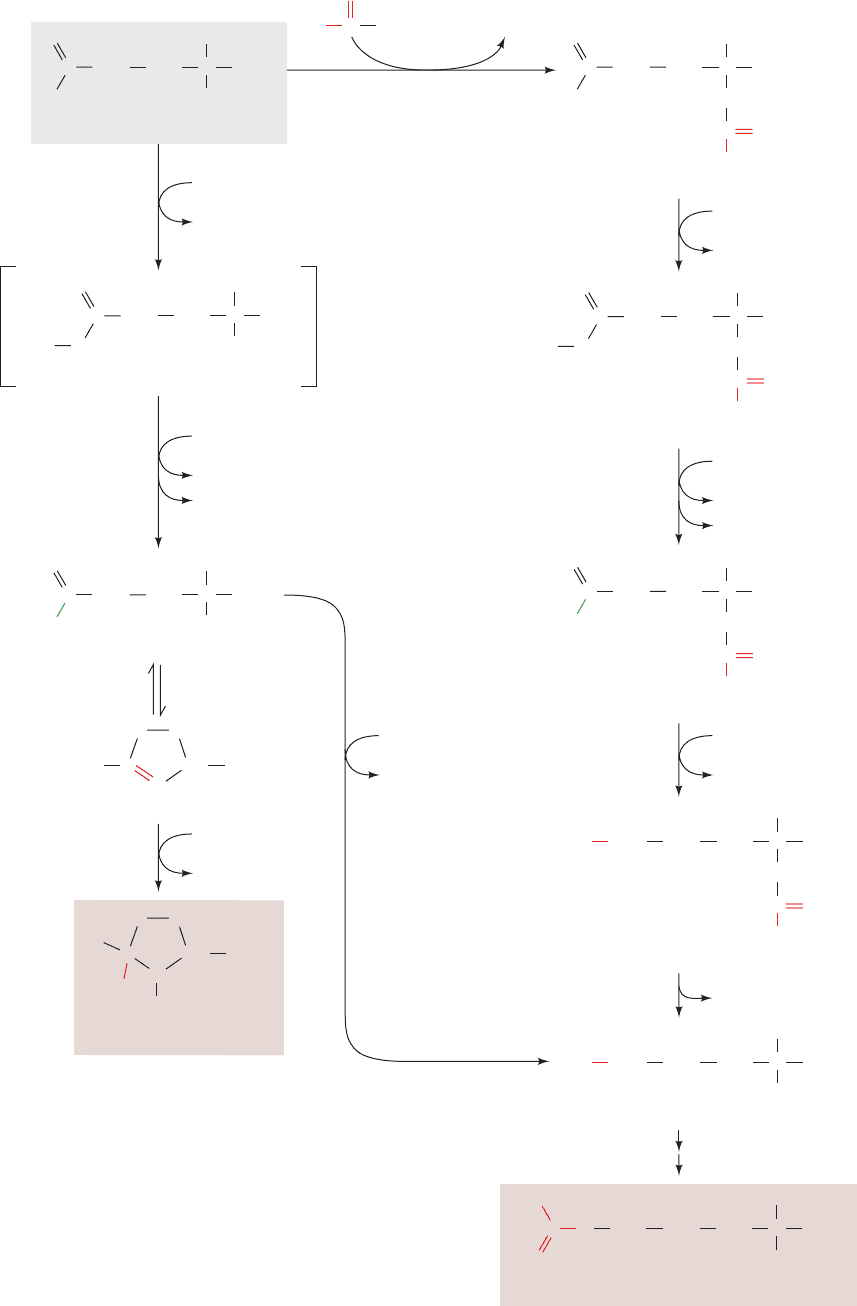
1070 Chapter 26. Amino Acid Metabolism
CC
CH
2
CH
2
COO
–
C
CH
3
CoASH CoASH
NH
3
+
H
Glutamate
5
O
O
–
O
CC
CH
2
CH
2
COO
–
NH
C
CH
3
H
N-Acetylglutamate
N-Acetylglutamate-5-phosphate
O
–
O
O
C
CH
3
O
C
CH
3
O
C
CH
3
O
CC
CH
2
CH
2
COO
–
NH
3
+
H
Glutamate-5-phosphate
O
O
2
–
O
3
P
CC
CH
CH
2
CH
2
CH
2
COO
–
CH
COO
–
NH
3
+
H
N
nonenzymatic
Glutamate-5-semialdehyde
⌬
1
-Pyrroline-5-carboxylate
Proline
O
H
2
C
H
CC
CH
2
CH
2
CH
2
N
H
COO
–
NH
3
+
H
Arginine
H
2
N
H
2
N
ATP
ADP
1
ATP
ADP
6
NAD(P)H
NAD(P)
+
4
Glutamate
α-Ketoglutarate
8
Glutamate
α-Ketoglutarate
10
9
11
NAD(P)H
NAD(P)
+
P
i
2
3
CC
CH
2
CH
2
COO
–
NH
H
O
O
2
–
O
3
P
CC
CH
2
CH
2
COO
–
NH
CH
3
COO
–
H
N-Acetylglutamate-5-semialdehyde
N-Acetylornithine
Ornithine
O
H
NAD(P)H
NAD(P)
+
P
i
7
C
CH
2
CH
COO
–
H
H
H
N
H
2
C
+
+
C
CH
2
CH
2
CH
2
COO
–
NH
H
H
3
N
+
C
CH
2
CH
2
CH
2
COO
–
NH
3
+
urea cycle
H
H
3
N
Figure 26-57 The biosynthesis of the “glutamate family” of amino
acids: arginine, ornithine, and proline. The enzymes catalyzing proline
biosynthesis are (1) ␥-glutamyl kinase, (2) dehydrogenase, (3)
nonenzymatic, and (4) pyrroline-5-carboxylate reductase. The enzymes
catalyzing ornithine biosynthesis are (5) N-acetylglutamate synthase,
(6) acetylglutamate kinase, (7) N-acetyl-␥-glutamyl phosphate
reductase, (8) N-acetylornithine-␦-aminotransferase, and
(9) acetylornithine deacetylase. An alternate pathway to ornithine is
through Reaction 10, catalyzed by ornithine-␦-aminotransferase.
Ornithine is converted to arginine (11) via the urea cycle (Fig. 26-7,
Reactions 2–4).
JWCL281_c26_1019-1087.qxd 6/8/10 9:38 AM Page 1070
